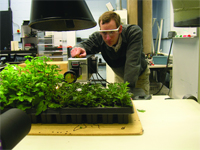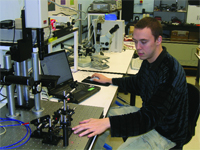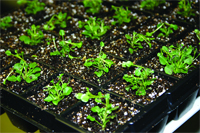
Features
Business
Research
Spotlight on crop photonics: Niagara College on cutting edge in researching new technology
April 3, 2008 By Dave Harrison
Niagara College researchers in Ontario are helping shed more light on
one of the newest technologies to be applied in the greenhouse.
Niagara College researchers in Ontario are helping shed more light on one of the newest technologies to be applied in the greenhouse.
Literally more light.
 |
| Prof. Alex McGlashan lines up the laser over a tray of mums. |
 |
| A closeup of the laser. |
 |
| Lab technician Curtis LaPlante completes an analysis of the spectral reflections off of powdery mildew caused by the laser induced fluorescence. |
 |
| A tray of campanula plants immediately after laser trimming. PHOTO COURTESY ALEX MCGLASHAN |
 |
| Alex McGlashan takes some diseased plants out of the department’s growth chamber. |
Professors Alex McGlashan (photonics technology) and Olga Piedrahita (horticulture) are principal researchers on a pair of laser-based studies with greenhouse crops. It’s not that common to have programs as diverse as applied physics and horticulture working together on applied research projects.
Photonics involves the generation and application of light. Traditionally, it’s been used in precision laser cutting, machining and welding in manufacturing; in video display and projection technologies; and with fibre optics, among other uses.
Having Niagara College involved in this leading-edge research is a natural, given its well-established and highly regarded school of horticulture. It also has one of only two photonics programs in Ontario, and there are only about a half-dozen or so similar programs in the U.S.
It’s also situated in the heart of one of North America’s largest greenhouse regions. There are some 265 greenhouses in the area, generating annual sales of well over $225 million. There are also dozens of key industry suppliers based in the region.
Photonics has considerable potential in horticulture, says McGlashan, and the school is contributing to its development.
The first project was suggested a few years ago by Sunrise Greenhouses, a local potted plant producer long known for innovation. The company asked whether laser technology could be used as a non-contact pruning system. Mechanical shears or blades can spread diseases and lead to significant crop losses.
“We began discussing it among ourselves,” recalls McGlashan, “and said, ‘sure, why not!’”
This was one of the first applied research initiatives undertaken by the college. “It’s been quite successful,” says McGlashan. “It hasn’t led to a commercial cutting machine yet, but we’ve done a lot of preliminary research and the technology is promising. It’s just a matter of taking it to the next step and building a prototype.”
Photonics offers a number of advantages in plant trimming. “The main thing is that it’s a non-contact process,” he notes. Unlike knives and blades, you’re not wounding the plant and leaving it susceptible to infection and disease transmission.
And as a bonus, the laser is quite the precision tool. It can be adjusted to deliver two levels of power at the same time. This means the stem can be effectively cauterized, while the trimmed material “cut” away is left open for easier replanting.
The process should be cost-effective, though those numbers won’t be known until a prototype is developed. Capital costs will be a little higher than traditional pruning methods because the laser itself is worth about $20,000. However this investment should be more than offset through reduced energy costs. As well, maintenance costs will be quite low since there are no moving parts.
The system works best with woody plants, since they have less water content. The laser selected for the research operates in the far infrared spectrum, almost a heat ray. “If you have a plant with a high moisture content, the laser will be absorbed by that material. It will quickly convert the water into steam.” The plant would be blown apart.
There are other laser systems, he said, that might work better on plants with higher water content.
The second project is working to develop laser technology to detect plant diseases. The goal is to be able to identify a problem even before it becomes visually evident. Researchers are using a spectro-photometer to analyze wavelengths produced by laser scans of plant material. Those with diseases will have different wavelengths than healthy plants. Detection will be immediate and accurate.
“Olga’s group has been taking care of growing the plants, while we’re involved with the actual identification process,” said McGlashan. “We’ve had some positive results, but a lot more needs to be done. It’s still pretty early.”
Students are quite enthusiastic with the research. “This takes them beyond the classroom.”
Print this page